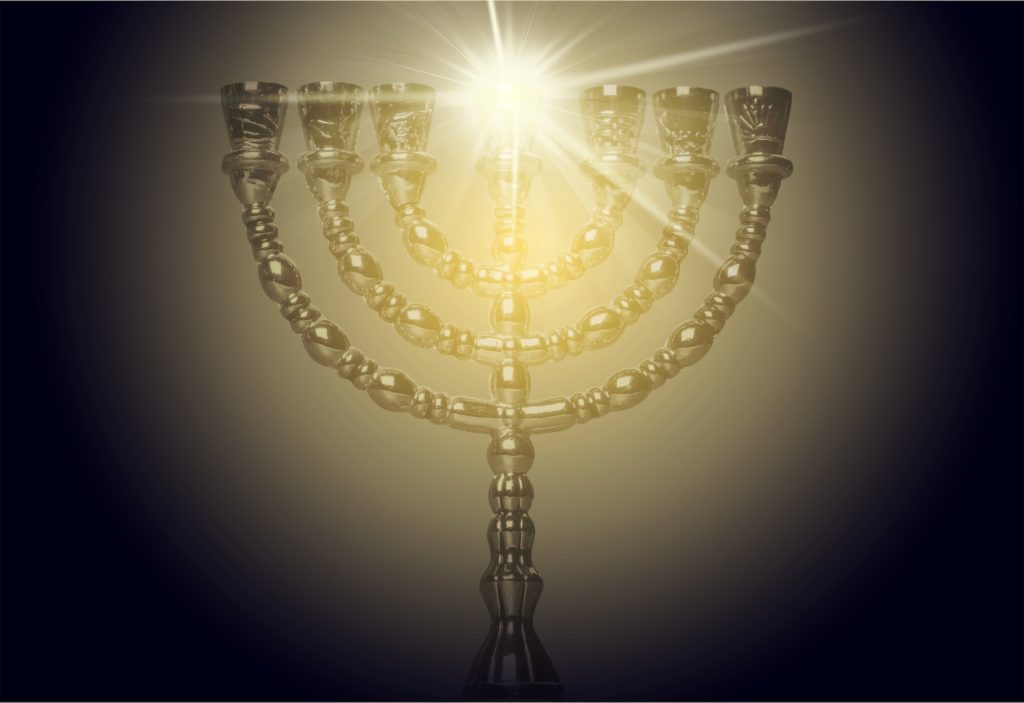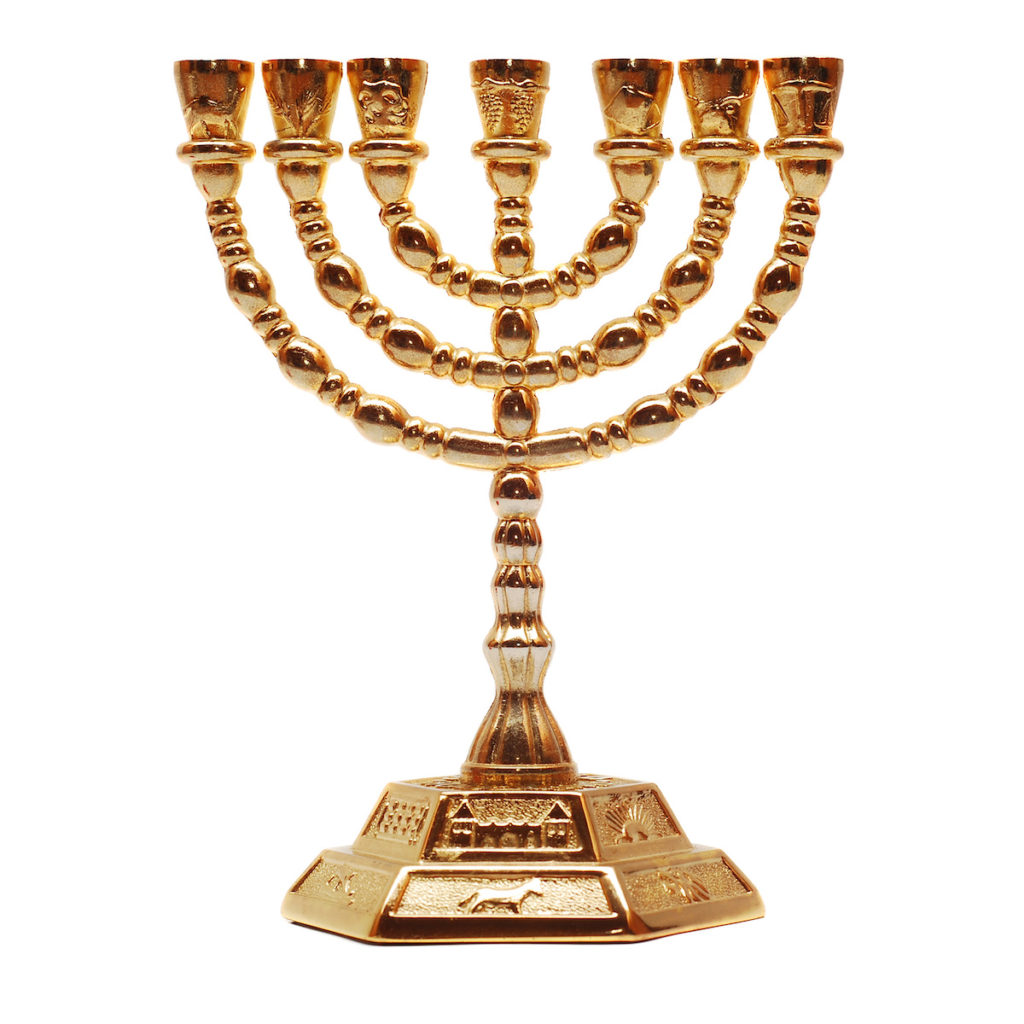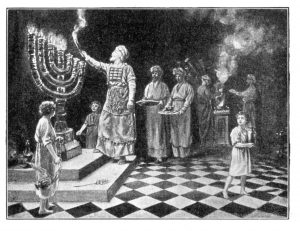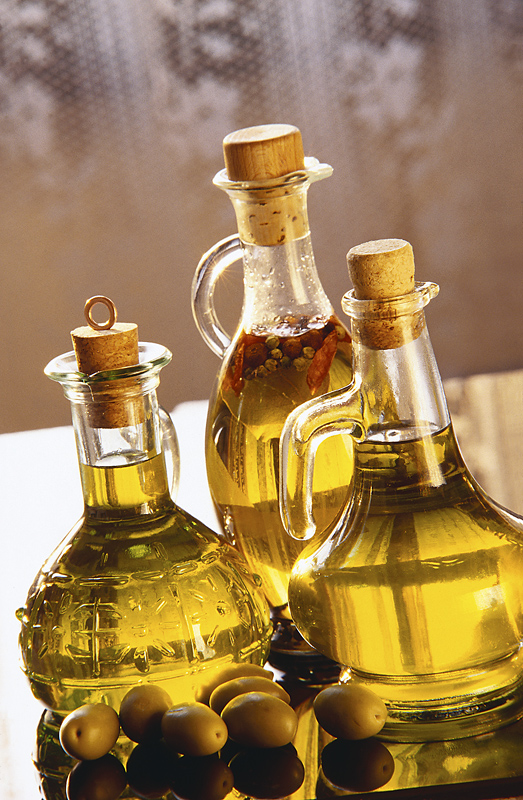In this video, we tie together the seven-branched, the importance of Shavuot or the biblical Feast of Pentecost in the context of the Tabernacle of Moses as it relates to the seven steps in the biblical plan of salvation. That’s a mouthful, but we inter-relate these seemingly disparate pieces of the puzzle to form a beautiful picture as it relates to new covenant followers of Yeshua (Jesus) the Messiah. Please enjoy this brief, power-packed presentation. For more intriguing information on the Tabernacle of Moses as it relates to YHVH’s plan of salvation, go to https://www.hoshanarabbah.org/teaching.html#tabernacle and https://www.youtube.com/playlist?list=PL5EzE5DQnrHdQZElQKo70hpY9b4a4dqOb, https://www.youtube.com/watch?v=v9z1y-RI-sY&list=PL5EzE5DQnrHdQZElQKo70hpY9b4a4dqOb&index=2.
Tag Archives: Menorah
Are YOU a living menorah?

Numbers 8:2, The menorah. The phrase toward the face of the menorah is an interesting one. The Jewish sages teach that the three wicks on the right and the three on the left were all directed toward the menorah’s central stem, thus concentrating light toward the center. The menorah symbolized that YHVH is the Source of all light (The ArtScroll Stone Edition Chumash, p. 775). What are the connotations of this for a believer in Yeshua? How did Yeshua describe himself? (See John 8:12; 9:5.) Moreover, what did he mean when he said that “I am the vine and you are the branches?” (John 15:5) What does this mean and how is this pointing to a type of human menorah? Now relate this to the seven Messianic assemblies of Revelation 2 and 3 being likened to menorahs (Rev 1:13, 20). Is Yeshua the center of all that we do? Do we place all of our focus on him? Can we say, as the Apostle Paul did, that “in him we live and move and have our being” (Acts 17:28)? Does the power of his resurrected life and anointing flow through you even as oil was in the menorah and sap flows through a tree to its branches?
Redeemed Israelites Are That Menorah
The Scriptures plainly states that Yeshua and his body of followers are likened to a tree of which the seven-branched menorah that adorned the mishkan (tabernacle) in the wilderness as well as the sanctuary of Solomon’s Temple is a picture. Furthermore, remember what Yeshua said in John 15:5? “I am the vine and you are the branches …” This is a perfect picture of the menorah, which has a central trunk with six (the number representing man) branches growing out of the trunk. Remember what Yeshua said in Matthew 5:14–15, that his followers were to be lights upon a lampstand on a hill for all the world to see—a clear allusion in the mind of anyone in Yeshua’s audience to the temple’s menorah (which was upon the Temple Mount like a light on a hill).
Additionally, when a redeemed believer in and follower of Yeshua is in a sacred state of worshipping his Master and Savior, he will often lift his arms heavenward. Not only is this the universal sign of surrender (in this case to one’s Heavenly Master), but when we lift our hands our bodies are actually forming a human menorah. By doing this, in worship we are acting out what we are—a lampstand to the world radiating forth the good news of the truth and love of Yeshua.
In fact, The Scriptures shows us that the menorah, and not the cross, is the symbol of Yeshua’s spiritual body of believers. We see this in Revelation 1:12, 20 and 2:1 where the seven congregations are symbolized as a seven-branched menorah! The menorah here is the symbol of the congregation of redeemed believers.
Though the cross is representative of the redemptive work Yeshua accomplished on our behalf, it is not the symbol of the body of believers, commonly called the “church,” but the menorah is! Furthermore, in Jewish thought, the menorah is analogous to an olive tree (the ancient temple menorah was constructed of hollow tubes of solid gold filled with olive oil that burned when lit), to which the Apostle Paul makes reference in Romans 11, as representing the tree of life (which ultimately represents Yeshua) into which all must be grafted if they are to be part the spiritual body of Yeshua and have his eternal life.
Cracking the Case of the Menorah, 12 Loaves of Bread and the Blasphemer as It Relates to the Modern Church

Leviticus 24 Overview
Leviticus 24 is one complete thought. The next thought begins with “And YHVH spoke to Moses in Mount Sinai saying…” in chapter 25. Caring for the tabernacle’s menorah, the 12 loaves of show bread and dealing with a blasphemer upon closer analysis aren’t three disparate and unrelated subjects, but indicate a continuum of thought that eventually relates to the modern mainstream church. Let’s see how.
Leviticus 24 is divided into three subsections: caring for the menorah, baking and placing the show bread, and punishment for the blasphemer. Each new section begins with the Hebrew word vav meaning “and,” which expresses a new thought, but is also a continuation of the previous thought. What do these three sections have to do with each other?
The menorah is a spiritual picture of Yeshua and the redeemed believer. It is also a prophetic picture of Yeshua who is the tree of life to which each redeemed Israelite is attached and draws his spiritual sustenance through the Spirit of Elohim. (Yeshua is the vine and the saints are his branches, John 15:1.) The gold in the menorah represents pure, godly character of righteousness. A menorah produces heat and light through its flame. Light represents the fruit of the Spirit of Elohim, and heat represents the power of the gifts of the Spirit. This is how a saint reaches the world: he is a light in the darkness around him and lets his light shine through the fruit of the spirit, and then reaches the world through the supernatural power gifts of the Spirit. The menorah also represents the Feast of Weeks or Shavuot when YHVH gave his people his Torah instructions in righteousness, and then latter wrote his Torah on their hearts by his Spirit in Acts chapter two on the day of Pentecost.
The show bread is a picture of redeemed Israel (the twelve tribes) bringing the bread of life, the Word of Elohim, to the world. The bread was covered in frankincense representing the prayers of the saints not only praising YHVH, but interceding for those who are spiritually lost.
The death of the young blasphemer is what happens when parents don’t raise their children correctly by reaching out to them with the truth of Torah—they blaspheme Elohim and are killed in judgment. Perhaps the Israelite woman had married an Egyptian who was not a believer in Elohim and the Torah and thus she was unequally yoked with a heathen unbeliever. Perhaps they were both followers of Elohim, but they raised their child incorrectly by not teaching him the lover and fear of Elohim—giving him the spiritual bread of life (represented by the table of showbread). Either way, the Israelite woman (a picture of the church) was not discipling her child in the word of Elohim and not being a spiritual light to him (represented by the menorah) and she lost her child because of it. How many redeemed believers (and church leaders) spiritually abort their children because they didn’t properly disciple or raise them in the Torah-Word of Elohim?
The Golden Menorah and YOU

Exodus 25:31–39, Menorah of pure gold.The menorah was beaten out of a solid ingot of pure gold and stood on the left side of the holy place inside the tabernacle. It was the only light in the holy place. The menorah had seven branches with three on either side of a central stem. Each branch had three decorative cups, a knob and a flower resembling that of an almond flower. The cups were called lamps and each was filled with the purest olive oil and contained a wick that was lit. The menorah was lit each day, and each of the six outer lamps were designed so that when lit its flame pointed toward the central stem. The menorah had tools—tongs and spoons—to tend the wick. These implements were used to clean and to prepare the lamps and to remove the previous day’s ashes.
The menorah is a picture of Yeshua, the Tree of Life, who likened himself to a vine and his followers to branches” (John 15:1–7). It also pictures the idea that the saints are members of the body of Yeshua (1 Cor 12:12) and are established in him (2 Cor 1:21). His followers are connected to him, draw sustenance from him, and the spiritual light of their lives point toward him in all that they do. Believers are to be “on fire” for doing the work of Yeshua. The Spirit of Elohim directed by the Torah—both pictured by the olive oil—fuels that fire. On the Day of Pentecost, the believers in the upper room received fire of YHVH’s Spirit and had his Torah-law written in their hearts. Through the empowerment of the Spirit—both the fruits and the gifts—the saints were able take the light of the gospel out to the world. The significance of the menorah in the believer’s life is evidenced by the fact that Scripture reveals that it (not the cross) is the actual symbol for assembly of believers in Yeshua (Rev 1:12,20).
The Golden Menorah in More Detail
The menorah represents the tree of life; the oil represents the Spirit of Elohim in the believer’s life. It also represents Yeshua the tree or vine with believers as the branches grafted in to the “trunk” of the tree or Yeshua and receiving the Spirit of life from him. As a result of Yeshua’s Spirit in the believer’s life the fruits and gifts of the Spirit of Elohim shine like a menorah on a hill into the surrounding darkness of this world. Gold represents the pure (divine) character of Yeshua and the believer, and oil represents the Spirit of Elohim through whose work in the believer’s life that pure gold-like character is formed and refined. Prophetically the menorah points to the Day of Pentecost or Feast of the Harvest of First Fruits (Shavuot) when the Spirit of Elohim was poured out upon YHVH’s people and the Torah-law was written on their hearts empowering them to walk in the paths of Torah-light/righteousness (Ps 119:105, 172) and to share the good news or gospel with others.
It is estimated that the menorah was constructed of 90 pounds of gold, which is 1440 ounces. If gold is $1200 per ounce the menorah would have been worth $1,728,000 in the value of the gold alone, not including the workmanship to construct it.
Some believe that the light of the menorah was reflected to point only forward. It was the only light in the set-apart place. We are to go forward only in our spiritual walk, not backward. Advance spiritually in light, but retreat and you do so in darkness (Ps 119:105).
The almond tree is the first fruit tree that blossoms in the spring in Israel. Yeshua is the firstborn among many brethren. The seven branches of the menorah, which are a picture of Yeshua, corresponds to the seven spirits of YHVH in Isaiah 11:2 and Revelation 4:5.
The wicks of the menorah were made from the priest’s worn out or discarded garments. From this we learn that we can’t discard the work of yesterday’s ministers, for we stand on their shoulders and use what they put into us to light our path spiritually to see what is ahead for us. What are we leaving behind us for the next generation?
Matthew Henry says in his biblical commentary on Exodus 27:20 that the pure oil signifies the gifts and fruits of the Set-Apart Spirit which all believers receive from Messiah (Mashiach) who is the oil-anointed One. Mashiach is the vine to which we are attached, for we are the arms and branches (John 15:1–2) and the branches are attached to the sustenance-carrying vascular system of the main trunk (as pictured by the hollow-tubed seven-branched gold menorah). The menorah is another picture of Yeshua who is the tree of life to which we must be attached. Only then will we be lights shining the fruits and gifts of the Spirit into the darkness of men’s lives as Yeshua commanded us to be (i.e. menorahs on a hill, Matt 5:14–16). That is why the symbol of the elect body of believers is the menorah as we see in Revelation 1:13 and 20.
The menorah, not the cross should be the Christian symbol

Numbers 8:2, The menorah. The phrase toward the face of the menorah is an interesting one. The Jewish sages teach that the three wicks on the right and the three on the left were all directed toward the menorah’s central stem, thus concentrating light toward the center. The menorah symbolized that YHVH is the Source of all light (The ArtScroll Stone Edition Chumash, p. 775). What are the connotations of this for a believer in Yeshua? How did Yeshua describe himself? (See John 8:12; 9:5.) Moreover, what did he mean when he said that “I am the vine and you are the branches?” (John 15:5) What does this mean and how is this pointing to a type of human menorah? Now relate this to the seven Messianic assemblies of Revelation 2 and 3 being likened to menorahs (Rev 1:13, 20). Is Yeshua the center of all that we do? Do we place all of our focus on him? Can we say, as the Apostle Paul did, that “in him we live and move and have our being” (Acts 17:28)? Does the power of his resurrected life and anointing flow through you even as oil was in the menorah and sap flows through a tree to its branches?
Redeemed Israelites Are That Menorah
The Scriptures plainly states that Yeshua and his body of followers are likened to a tree of which the seven-branched menorah that adorned the mishkan (tabernacle) in the wilderness as well as the sanctuary of Solomon’s Temple is a picture. Furthermore, remember what Yeshua said in John 15:5? “I am the vine and you are the branches …” This is a perfect picture of the menorah, which has a central trunk with six (the number representing man) branches growing out of the trunk. Remember what Yeshua said in Matthew 5:14–15, that his followers were to be lights upon a lampstand on a hill for all the world to see—a clear allusion in the mind of anyone in Yeshua’s audience to the temple’s menorah (which was upon the Temple Mount like a light on a hill).
Additionally, when a redeemed believer in and follower of Yeshua is in a sacred state of worshipping his Master and Savior, he will often lift his arms heavenward. Not only is this the universal sign of surrender (in this case to one’s Heavenly Master), but when we lift our hands our bodies are actually forming a human menorah. By doing this, in worship we are acting out what we are—a lampstand to the world radiating forth the good news of the truth and love of Yeshua.
In fact, The Scriptures shows us that the menorah, and not the cross, is the symbol of Yeshua’s spiritual body of believers. We see this in Revelation 1:12, 20 and 2:1 where the seven congregations are symbolized as a seven-branched menorah! The menorah here is the symbol of the congregation of redeemed believers.
Though the cross is representative of the redemptive work Yeshua accomplished on our behalf, it is not the symbol of the body of believers, commonly called the “church,” but the menorah is! Furthermore, in Jewish thought, the menorah is analogous to an olive tree (the ancient temple menorah was constructed of hollow tubes of solid gold filled with olive oil that burned when lit), to which the Apostle Paul makes reference in Romans 11, as representing the tree of life (which ultimately represents Yeshua) into which all must be grafted if they are to be part the spiritual body of Yeshua and have his eternal life.
Olive Oil and the Saint
Exodus 27:20–21, They shall bring pure oil. Olives, olive oil and the olive tree are very significant ancient biblical symbols. Most notably, olive oil was used for anointing and for burning in the seven-branched menorah—a picture of redeemed Israelite believers comprised of many different congregations (Rev 1:12–13). This olive oil was pure and the olives were beaten or pressed to produce oil for light (Exod 27:20).
How does this relate to the believer’s life, so that one can be the light of the world that Yeshua commanded us to be? (See Matt 5:14–16 cp. Acts 14:22; Rom 8:17; 2 Tim 3:12; 1 Pet 4:12–14; Jas 1:2–3.)
The priests attended to the menorah to keep it burning continually from evening till morning. This reminds us of Yeshua’s Parable of the Ten Virgins (Matt 25:1–13), where Yeshua’s exhorted his disciples to be like the wise virgins who kept their lamps trimmed and full of oil as they were watching and waiting for their bridegroom to come.
In the Parable of the Ten Virgins, the level of oil in each virgin’s lamp was the factor that determined whether they would be allowed entrance into the bridegroom’s wedding or Continue reading
Is the oil level in your spiritual engine low or high?

Herodian oil lamps from the first century A.D. The lamp on the left is a replica. The lamp on the right is an actual 2000 year old clay lamp from the Holy Land.
Exodus 27:20–21, They shall bring pure oil. Olives, olive oil and the olive tree are very significant biblical symbols. This oil was used for anointing and for burning in the seven-branched menorah—a picture of redeemed Israelite believers comprised of many different congregations (Rev 1:12–13). This olive oil was pure and the olives were beaten or pressed to produce oil for light (Exod 27:20). How does this relate to the believer’s life, so that he can be the light of the world Yeshua commanded him to be (see Matt 5:14–16 cp. Acts 14:22; Rom 8:17; 2 Tim 3:12; 1 Pet 4:12–14; Jas 1:2–3)?
The priests attended to the menorah to keep it burning continually from evening till morning. This reminds us of Yeshua’s Parable of the Ten Virgins (Matt 25:1–13), where Yeshua’s exhorted his disciples to be like the wise virgins who kept their lamps trimmed and full of oil as they were watching and waiting for their bridegroom to come.
In the Parable of the Ten Virgins, the level of oil in each virgin’s lamp was the factor that determined whether they would be allowed entrance into the bridegroom’s wedding or not. Therefore, what is the significance of olive oil (the fuel for the lamps) scripturally? There are several.
Olive oil was used in consecrating kings and priests for YHVH’s service (see 1 Sam 16:13; 1 Kgs 1:39; Lev 8:12).
Olive oil symbolizes YHVH’s rich blessings on one’s life, was used for consecrating the tabernacle and its contents (Lev 8:10).
Olive oil was a medicinal agent for healing (Isa 1:6; Luke 10:34).
Olive oil is also a scriptural metaphor for YHVH’s anointing on one’s life (see Ps 23:5; 133:2; Zech 4:12–14).
Olive oil is a biblical metaphor for gladness or joy (note Ps 45:7; Prov 27:9; Isa 61:3; Heb 1:9).
Olive oil speaks of healing by the laying on of hands (read Mark 6:13; Jas 5:14).
Olive oil is a symbol of prosperity (see Deut 32:24).
In Jewish thought, olive oil is also a metaphor for Torah, since it is a comfort to the head and body even as are the words of the Torah (Everyman’s Talmud, by Abraham Cohen, p. 134).
Oil in the Parable of the Ten Virgins oil is generally recognized to be a symbol of the blessing and anointing of YHVH’s Set-Apart Spirit functioning in one’s life.
Let us not forget that the same is the spiritual force that Spirit leads one into YHVH’s Torah-truth (John 15:26; 16:13). The five foolish virgins’ lack of oil speaks of their lacking YHVH’s anointing and blessing, that their lives were not fully consecrated to him, that they were deficient in YHVH’s Spirit and were not walking in the fullness of his Torah-truth. Torah teacher, Dean Wheelock characterizes the foolish virgins’ lack of oil in this way:
The foolish squander their oil, their precious oil of Torah instruction, which tells them how to live their lives in a righteous manner. Meanwhile the wise hang on to their Torah learning, and thereby save their oil for that time when it is needed. And the time when it will be most needed is when Messiah arrives to take us to the wedding. Then we will need all of the Torah oil we can muster. That is what the “foolish virgins” were missing. They did not have an adequate supply of understanding of the Torah, they were not living a Torah-centered life, they had not prepared themselves adequately to be the wife of the Messiah Yeshua, the one who as the “Living Torah” when he walked the earth some two thousand years ago. (Hebrew Roots Magazine, Sept./Oct. 1997, article entitled “Oil For Our Lamps,” by Dean Wheelock, p. 10)
In the Scriptures, how is the lamp viewed metaphorically? (Read 2 Sam 22:29; Ps 119:105; Prov 6:23.) Believers are to be leading lives reflective of YHVH’s light and are to be lamps or lights shining in the darkness of this world (note Matt 5:14; Luke 12:35; Phil 2:15). The ceramic lamps used in biblical times are an apt symbol of our physical lives, which the Scriptures describe as vessels of clay, which contain the Spirit of YHVH, for the spirit of man is the candle or lamp of YHVH burning inside of man (Prov 20:27) and, our lives are earthen vessels that contain YHVH’s spiritual light (2 Cor 4:6–7). At the same time, the pure gold menorah in the tabernacle shows us although we may now be mere vessels of clay as we walk this earth, it is our spiritual destiny, upon receiving our glorified bodies at the resurrection to be gold in that we will be like Yeshua (1 John 3:2).


